Learn about common challenges and key specifications to consider when selecting pressure sensors for hydraulic systems with pressures greater than 50 bar (725 psi).
Contributed by By Daniel Mullen, Product Manager, Sensata Technologies
Pressure sensors are critical components in fluid power systems, where they are used in a control loop with a Program Logic Controller (PLC) to help control the fluid pumps and ensure the system pressure is within a specified range. If a pressure sensor was to fail in these types of applications, the feedback to the control of a motor would be interrupted. This could lead to equipment failure, costly downtime or potential safety issues for workers using the equipment.
Challenges and top 5 specifications to consider for selection
Understanding the environment and operating conditions of an application is necessary to specify the best pressure sensor for a system. In hydraulic applications, addressing some of the most common challenges will help determine the right specifications for the job.
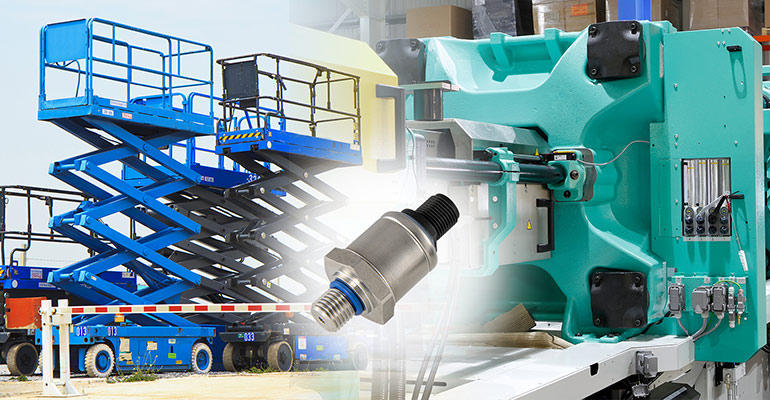
High Pressure — These applications are characterized by high fluid pressures of greater than 50 bar (725 psi), which means robust components designed specifically to handle higher pressures are required to maintain safe and reliable operation. In many of these systems, the fluids may be hazardous and in combination with the high pressures and temperatures, mean that a leak could be very dangerous.
Sense element technologies — There are a few sensor technologies that are commonly used for pressure sensors in high pressure range applications of greater than 50 bar (725 psi), with pros and cons for each.
Thick Film Ceramic sense elements are made by printing four resistors, arranged to form a Wheatstone bridge, to the non-process side of a ceramic substrate. As pressure is applied to the process side, the ceramic substrate deforms causing physical change to the resistors and therefore a change to the electrical output signal. In high pressure systems, such as hydraulic applications, the ceramic substrate is more susceptible to cracking and breaking from repeated high pressure cycling and high-pressure spikes than alternative metal substrate technologies. In addition, ceramic sense elements cannot be welded to the process connection and therefore require an accompanying O-ring and locking mechanism to create the seal. This adds complexity to the sensor design and could be a point of potential leaks and failures.
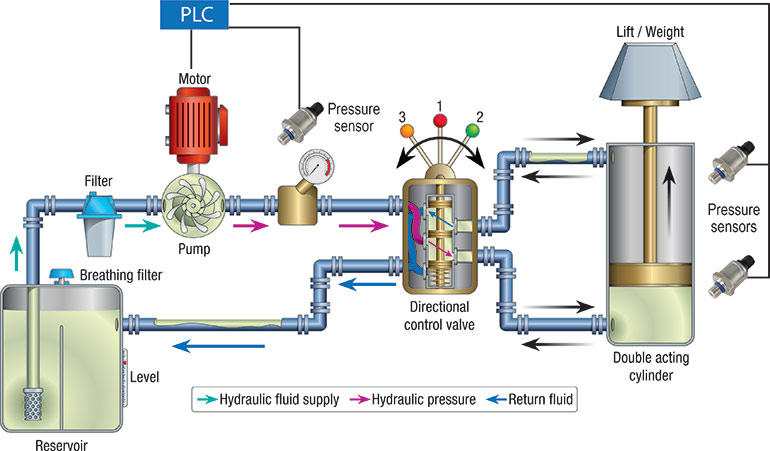
Thin Film Metal sense elements use the process of thin film deposition to form a Wheatstone bridge pattern of resistors onto the substrate. In this case, the operation of the sensor’s electronics is similar to thick film ceramic. A benefit of thin film technology is that the sputtering can be easily implemented on numerous types of materials. Also, because the sense element is metal (often stainless steel) it can be welded into the process port design, creating a hermetic seal with no need for O-rings. In this type of sense element design, poor bonding between the thin film sense element and port material could be an issue that would result in early component failure with endurance pressure cycling. Additionally, thin film manufacturing requires costly sputtering process equipment and a clean room, making production more expensive.
Micro-fused Strain Gauge (MSG) sense elements are made by glass bonding a silicon strain gauge to a metal substrate (typically 17-4PH or 316L stainless steels). This substrate is welded to the pressure port creating a hermetic process connection without the use of an O-ring, which prevents potential process fluid leaks into the sensor. MSG sense elements allow more design flexibility due to the small size of the strain gauges than the other sense element technologies. Also, MSG sense elements have excellent glass bonding between the gauge and the stainless-steel port which makes this type of technology more durable than thin film from a pressure cycling standpoint. Although thin film sense elements provide a more linear raw output, MSG technology can provide comparable accuracy at the sensor level through calibration, creating a more affordable sensor with the same or better accuracy.
Another advantage of MSG technology is the relative higher sensitivity (mV/V) compared to thin film. Because of this higher sensitivity, the pressure sensing element membrane can be designed thicker which increases the burst strength.
High pressure spikes and burst strength
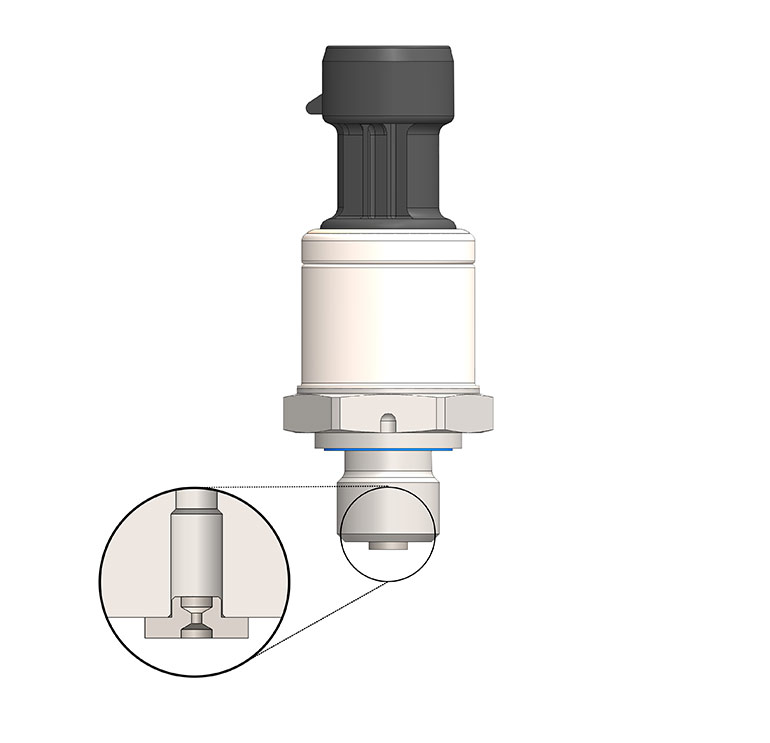
High pressure spikes can lead to component damage and failure if the pressure event exceeds a component’s rated burst or proof pressure. Burst pressure is the maximum pressure a device can be exposed to for two minutes without rupture and is typically specified as a multiple of the upper limit of the device’s operating pressure range. Repeated high pressure spikes that do not exceed a component’s rated proof and burst pressures can still lead to rupture and damaged pressure diaphragms over time, causing potential sensor failure and system leaks.
The internal port geometry and diaphragm thickness of the sense element contribute to the burst pressure that a sensor can withstand. Also, snubbers can be used to protect the pressure sensor from repeated high-pressure spikes. Snubbers reduce the size of the aperture that the fluid flows through, dampening the pressure spike before the fluid hits the sense element. For example, in construction machinery, the hydraulics used to manipulate large forks or buckets frequently make sudden stops or starts, or the vehicle turns around quickly. In each of these instances, the system and components are subject to large pressure spikes where a 10x burst strength rating would ensure that components maintain structural and operational integrity.
Shock and vibration
Hydraulic systems typically involve pumps, motors and large cylinders, all moving and generating vibration. Also, these systems are usually incorporated into larger systems which may cause or be exposed to higher levels of shock and vibration. If a component is overexposed to levels beyond what it was built to withstand, damage to the mechanical construction and electronics could result. Heavy vehicle applications such as off-road equipment, scissor lifts or forklifts are especially prone to experience shocks and higher levels of vibration.
While mechanical shock is a short, momentary impact that can transfer a burst of energy to a component from events like transportation or rough handling, vibration is a more continuous mechanical oscillation that can occur from running machinery like engines or that can be caused by an initial shock. Pressure sensors are often exposed to mechanical shock and vibration in hydraulic applications and the mobile machinery, compressors and engines that comprise the systems.
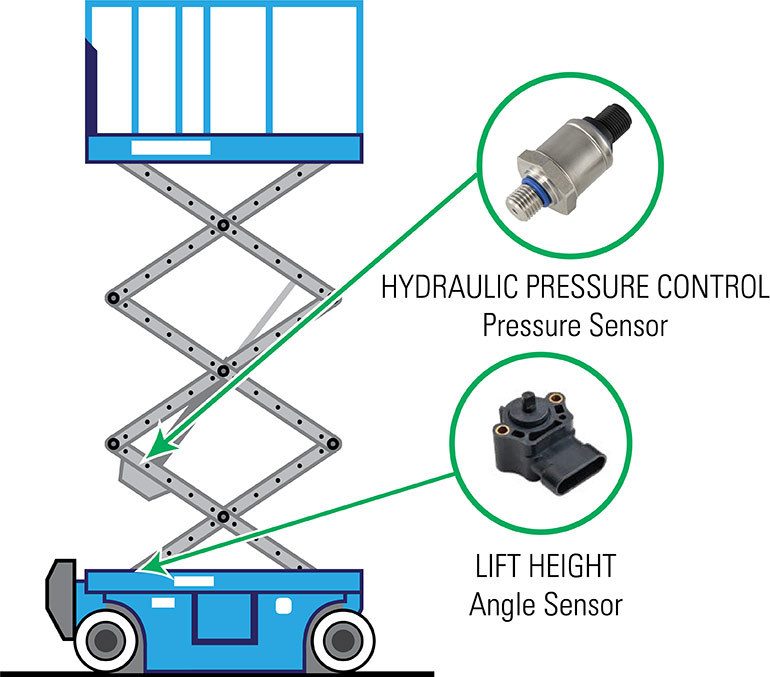
When selecting a pressure sensor for use in these applications, it is important to assess the test standards that suppliers use to rate their sensors to make sure the component is rated to withstand the potential shock and vibration of the system. Oftentimes, pressure sensor suppliers will test their sensors to IEC 60068-2-27 standards to show an indication of the level of mechanical shock that their sensor is capable of. For example, a rating of 500 g min would be best-in-class and would likely prevent potential damage and component failure in hydraulic applications.
In addition, the frequent running of compressors and motors in these systems means that all the components are subject to long periods of vibration exposure. Sensors from suppliers that offer more stringent testing and vibration ratings will test their sensors to IEC 60068-2-6. Qualifying a sensor to 30 g (10…2,000 Hz), will provide more reliable and long-lasting sensing solutions in application.
Electromagnetic Compatibility (EMC)
The high power levels and complex machinery that are often used in hydraulic applications mean that equipment is subject to electromagnetic emissions and electrostatic discharges that could damage the system if the components are not rated accordingly. For example, a hydraulic pump without a good ground connection could emit electrical noise or interference into the atmosphere or, in a mobile aerial work platform, an electric welding machine could be used on the scissor lift without a good ground connection. In each of these examples, there is an increased risk of electromagnetic emissions that could interfere with the sensor’s signal. In such scenarios, specifying sensors that have rigorous EMC standards including Enhanced Radiated Immunity (EMI) ratings of at least 150 V+/m and enhanced Electrostatic Discharge (ESD) ratings of ±8kV contact or ±15kV air will help to ensure adequate protection.
Pressure Sensors’ Critical Functions in Industrial Applications
Safety in Scissor Lifts
In applications such as scissor lifts, pressure sensors help to control the hydraulic pressure of the main cylinder, stabilizing the lift for a smooth, steady ride. In addition, when combined with an angle sensor, a pressure sensor can help control the platform overload condition, complying with ANS192 and EN280 safety standards. In these applications, it is especially important to consider redundancy of pressure sen
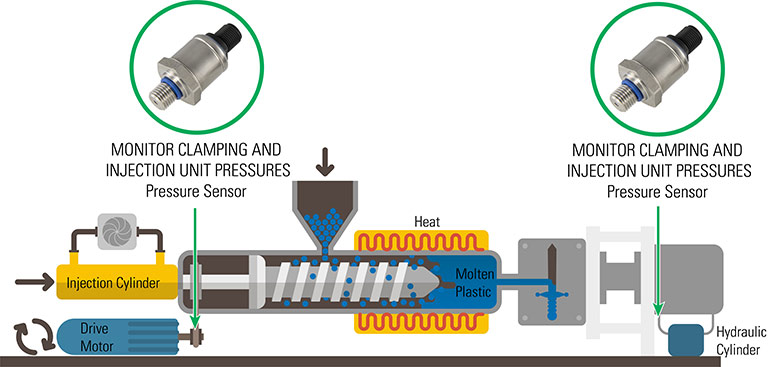
Though in general terms, injection molding involves the same type of hydraulic system as in scissor lifts, there are parameters that differ between the applications such as the fluids used and the motor and cylinder sizes. In injection molding, the hydraulic system is controlling the actuation of the molds as they clamp together and pull apart. The pressure sensor is often sensing feedback on the hydraulics of the mold actuation — providing that feedback to the pumps so that the motion is as repeatable and efficient as possible. A sensor failure would lead to downtime of the mold and reduced product output while using a robust and adequately rated pressure sensor can help minimize poor injection molded part quality and pro-long tool life.
These essential components help keep equipment running safely and efficiently – a failure due to incorrect specifications in the design process could lead to dangerous working conditions or costly downtime. Design engineers should carefully consider the frequent challenges encountered in hydraulic applications and key specifications such as sensing technology, burst strength, shock and vibration, and Electromagnetic Compatibility when selecting pressure sensors for these types of systems. Selecting components with more stringent ratings can help prevent component failure and increase the safety and reliability of the equipment.
Sensata Technologies
www.sensata.com

